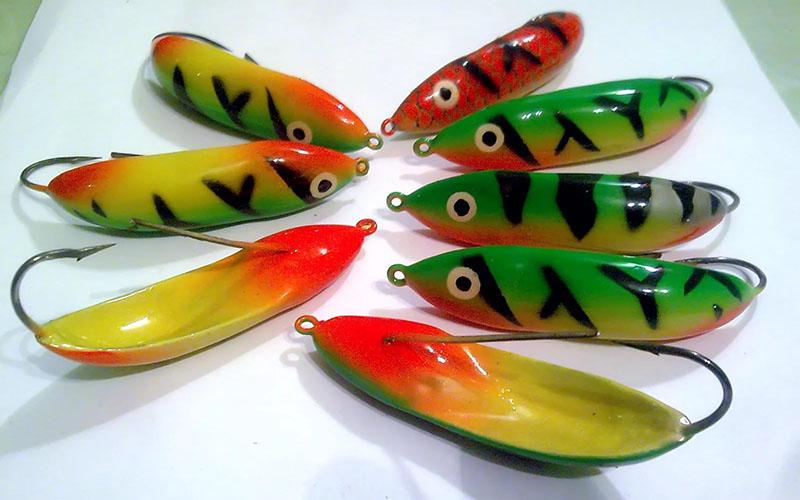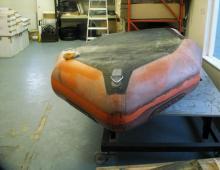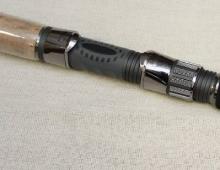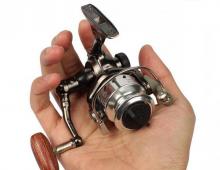Lures for pike - favorite bait among fishermen
Whatever they say about the new baits in spinning fishing, the spinner remains the most common tackle, and pike spoons are one of the most beloved among experienced fishermen.
Catching a metal fish with a certain skill gives very good results, and pike, if there is one in the casting area, will rarely leave this bait unattended.
Types of oscillators for pike and their structure
History of creation
It only seems that the spinner in the hunt for predatory fish was a constant companion of the angler many centuries ago. Not so this tackle and ancient. It was invented by an American Julio T. Buil in 1850. He was known in New York as a master of all kinds of fishing lures. This time he went the simple way - he sawed off the handle of the spoon and drilled two holes in it - one to tie the hook, the other for the fishing line.
Made in this way and then somewhat improved, pike spinners quickly gained popularity all over the world, and the basic principles of their design, developed by Buil, are still used today.
Structure
Any oscillator, which is quite a lot in different versions, has 4 basic principles of its design:
- body- this is the main imitation of pike prey can be of various shapes - from pot-bellied to elongated in length, depending on the type of fish that are found in a particular reservoir and attract pike;
- hook;
- fastening ring- it must combine invisibility and strength;
- swivel- this device prevents the fishing line from twisting and improves the imitation action of the bait.
As a rule, catchy spoons for pike are made of metal alloys. Most commonly used copper and brass, lead is also suitable, there are simple spinners made of steel. Some aesthetes make their own spinners from cupronickel.
Recently there have been plastic lures of such kind. But fishermen claim that pike take them reluctantly, they are more suitable for catching perch.
Types of spinners
Qualify 4 types of oscillating lures:
- for angling- here the choice is the largest, and each fisherman has his own preferences;
- for trolling- with this method, pikes are caught larger and more actively, and the tackle should be stronger and larger;
- for jig wiring- most often these are winter spinners, but in some relatively warm countries, vertical wiring is used at any time of the year and is considered fascinating;
- for surface shine- with this type of fishing in many reservoirs, pike is not active at all; but in May. After changing teeth, the gray predator also attacks such a bait.
Oscillations for pike - non-hooking

This type of bait is qualified separately and is somewhat differs from ordinary oscillators. These spinners seem to be more convex. To minimize hooks and breaks, they equipped with 1 or 2 hooks, no more, and have protective antennae or small petals - bends, which push the obstacle during flashing and take the hook away from it.
Non-hooks are usually used in twisted places when, for example, you need to catch a tree that has fallen into the water. They are good in reservoirs on small windows. Non-hooks in shallow water, in places overgrown with grass, also give good results with surface luster.
Many fishermen argue which fishing for pike on spoons is more catchy with such tackle - the one in which the antennae are fixed on the main petal, or the one where they are located next to the hooks. Most likely, for pike, this does not matter much. It is even believed that when catching this predator of reservoirs, you can use antennae of increased rigidity, - the pike, as a rule, does not pay attention to them and greedily grabs the prey right away.
Interestingly, depending on the time of year, the pike reacts to different types of unhooked spinners. spring spoon baubles for pike should be darker, but in summer, baubles of bright color and shiny are better but only on sunny days. In cloudy weather, predatory fish prefer darker lures.
When fishing on non-hooks, lure occurs, as a rule, near the shore, in fallen snags. So the spinning rod should not be long - 2.4 m is enough.
How to choose a vibrator

It is not worth chasing the brightness and brilliance of the spinner. Other characteristics are more appreciated here:
- spinner - a pike spoon should be major; it is better not to be interested in products less than 10 cm; when trolling, you can use a bait 15 cm long, this will allow you to get trophy specimens;
- the bait must have the so-called sweeping game;
- the most catchy spoons for pike, especially on a river with a current, as a rule, don't have big folds; the current can send them into a banal tailspin and scare away the pike;
- massive the spoon is especially good when catching pike in deep holes, because it quickly sinks to the bottom;
- bait often attracts pike planning.
Important! When catching pike, it is advisable not to conduct wiring at a fast pace; the spinner may begin to rotate, this will scare away the predator and even force it to leave its usual habitat.
fishing technique
How to catch
The best spinners for pike do not involve accelerated wiring, but do not exclude jerks. Especially promising is a small jerk up the bait from the bottom immediately after casting, the pike in this case probably thinks that the little fish went down for food, found something, and is now quickly hiding. This behavior is natural for small fish that are very shy, and the predator knows this.
In addition, the technique of such fishing contains a few more small secrets:
- start fishing as soon as possible closer to the bottom; then the horizon must be gradually raised;
- wiring desirable slow. But without monotony - here everyone has their own technique; it is useful to practice in open clear water before mastering a new type of bait or reel;
- very effective casting accuracy; immediately determine the place where, as you assume, the predator is standing; often the bite occurs instantly, as soon as the bait is next to the pike.
Attention! You should not leave the place without making at least 5 casts; the pike can literally be pissed off by the frequent appearance of the intended prey, and even if it is full, it can, in the end, rush to the lure.
Where to fish
Pike habitats in water bodies are easy to determine:
- one of the most promising places is at the edge of the thickets, only the bait must be brought as close to the plants as possible;
- pike often stands on the border of the forward and reverse currents; it is necessary to catch here from two opposite sides;
- the predator is often attracted by the places where small streams and streams flow into the reservoir; juveniles often gather there, attracted by the brought food; the pike needs it;
- often the pike begins its hunt on the depth differences;
- in summer, the gray predator likes to bask in the sun in shallow water, closer to autumn it goes into the pits; accordingly, in the summer months, light spinners are better suited for fishing; in autumn - heavier.
Homemade spinners

Do-it-yourself pike swings were made and still made by our grandfathers. Moreover, they also believed that the best oscillator for pike - homemade. Today there are several ways to make catchy spinners for pike, and they all have their own characteristics:
- still catchy baubles from ordinary spoon made of stainless steel, cupronickel or aluminum; in the latter case, it is advisable to solder the hook to the petal in order to increase the weight of the bait due to the solder; the spoon can be additionally bent to improve the game;
- metal tube lure; the tube is cut from two ends at different angles - this will give the bait additional playfulness;
- pre-made bait; here the fisherman has a huge material for fantasy; such tackle can be made by stamping, which speeds up the process;
- options from store spinners; often these baits, especially inexpensive ones, do not have the necessary buoyancy, but they are excellent blanks from which you can make a good wobbler by changing the bend of the petal and even the shape.
The best spinners
Everyone has their own list of them, but there are models that experienced fishermen prefer, despite the often expensive price.
Blue Fox Esox
 The good quality of this bait is that the predator of our rivers cannot bite through them because of the high quality; it is valued in summer because of its bright color and flattened, moreover still wide, shape. The lure moves smoothly in the water even with spinning errors.
The good quality of this bait is that the predator of our rivers cannot bite through them because of the high quality; it is valued in summer because of its bright color and flattened, moreover still wide, shape. The lure moves smoothly in the water even with spinning errors.
Mepps Cyclops
 It is also a very durable durable smooth-running spinner with an expensive, high-quality coating.
It is also a very durable durable smooth-running spinner with an expensive, high-quality coating.



